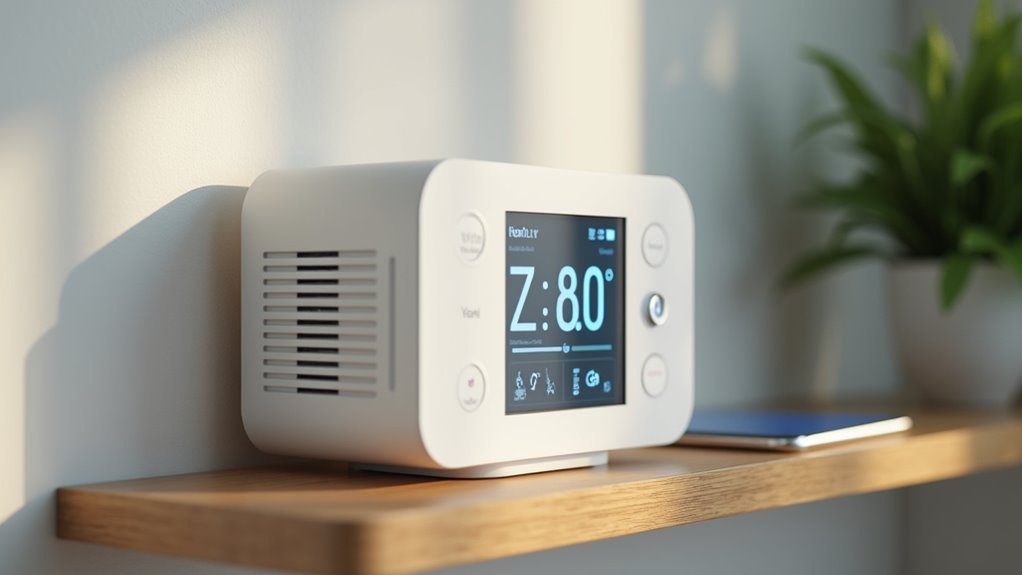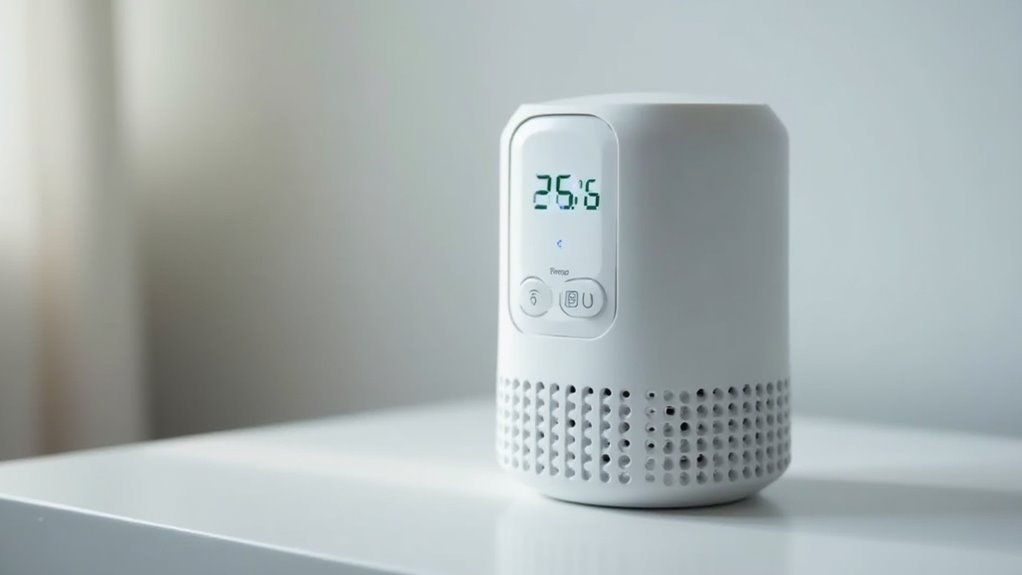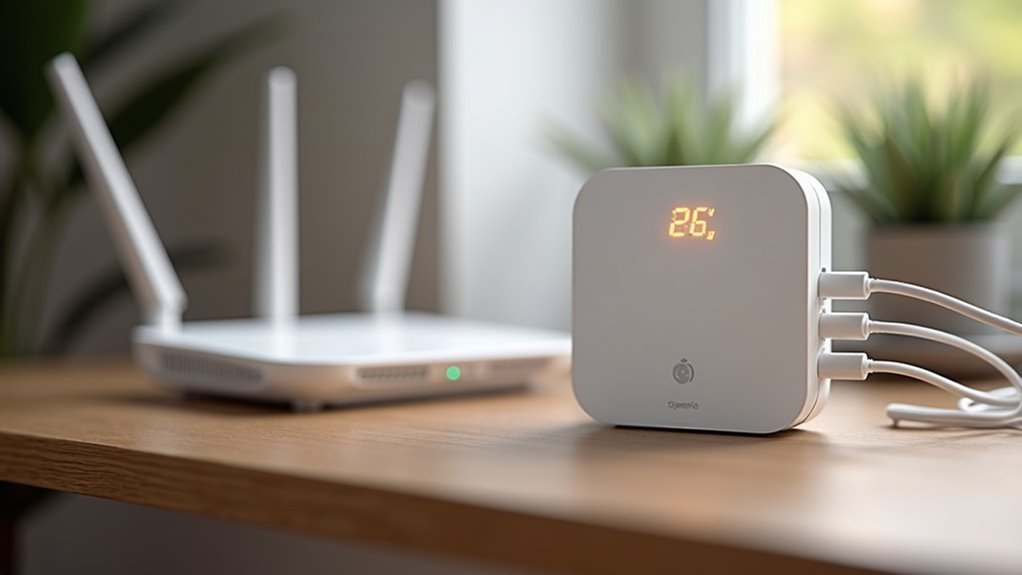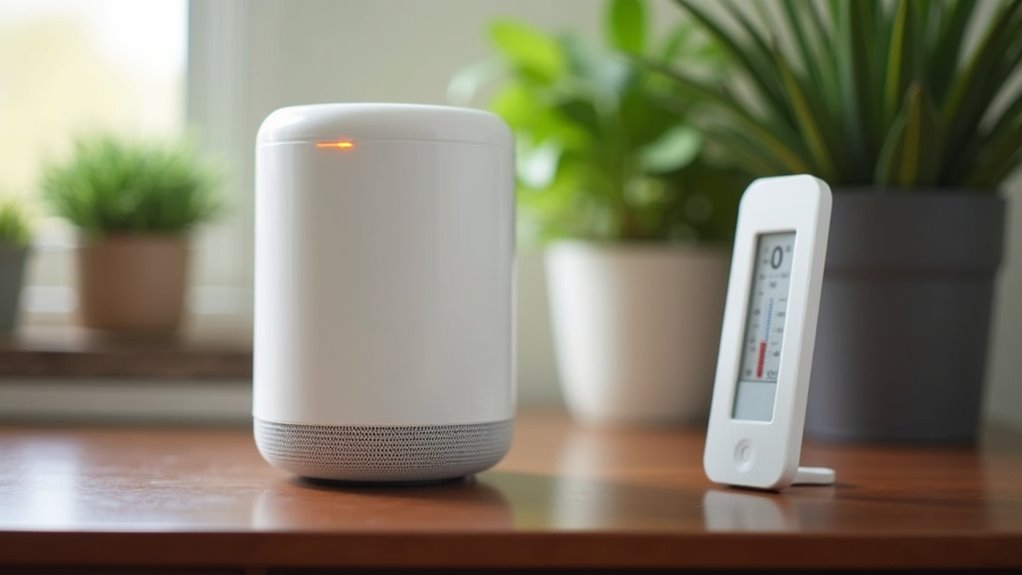You’re looking for HomeKit air quality monitors that track temperature, but you’ll quickly discover that not all devices offer this dual functionality. While some popular models like the Eve Room and Qingping Air Monitor Lite excel at combining temperature sensing with thorough air quality measurements, others focus solely on pollutants and VOCs. The key lies in understanding which specific features you actually need and how temperature data integrates with your existing smart home setup.
Understanding Temperature Monitoring in HomeKit Air Quality Devices

When you’re monitoring your home’s air quality, temperature tracking serves as a foundational element that directly impacts your comfort and health.
HomeKit air quality monitors like the Qingping Air Monitor Lite and Eve Room integrate temperature sensors to provide thorough environmental data. These devices don’t just measure temperature—they use it to understand how it affects your indoor air quality alongside other factors like humidity and VOCs.
Temperature monitoring combined with humidity and VOC tracking creates a comprehensive picture of your home’s air quality environment.
The Qingping Air Monitor Lite delivers high-accuracy temperature readings that refresh every second, ensuring you get real-time updates.
Eve Room presents this data on its high-contrast e-ink display for easy viewing. Through HomeKit integration, you can automate your HVAC systems based on temperature changes, optimizing both comfort and air quality throughout your home.
Eve Room Temperature and VOC Tracking Capabilities
You’ll find the Eve Room excels in both temperature monitoring accuracy and VOC detection capabilities through its advanced SGPC3 sensor from Sensirion.
The device delivers precise temperature readings while simultaneously tracking total volatile organic compounds (TVOC) in your indoor environment.
Its dual-monitoring approach guarantees you’re getting thorough data about your air quality that goes beyond basic temperature measurements.
Temperature Monitoring Accuracy
Although many air quality monitors struggle with temperature precision, the Eve Room delivers consistently accurate readings that complement its VOC tracking capabilities. You’ll find its high-contrast e-ink display provides clear real-time temperature data that’s easy to read from any angle. The device automatically tracks fluctuations, helping you understand how activities like cooking affect your indoor environment alongside humidity level changes.
| Feature | Performance | Battery Life |
|---|---|---|
| Temperature Accuracy | Consistent readings | Up to 6 weeks |
| VOC Detection | Real-time monitoring | Rechargeable |
| Display Quality | High-contrast e-ink | Power efficient |
Through the Eve app, you’ll access historical temperature trends and patterns. This thorough data helps you make informed decisions about your indoor climate management while maintaining the flexibility of wireless placement throughout your home.
VOC Detection Range
The Eve Room’s SGPC3 VOC sensor from Sensirion detects volatile organic compounds across an extensive range, maintaining its sensitivity over extended periods to deliver precise TVOC readings.
You’ll get thorough monitoring that tracks how temperature and humidity fluctuations affect your indoor air quality. The VOC sensor responds to various pollutants including cleaning products, paints, furniture off-gassing, and cooking emissions.
Combined with temperature tracking, you can identify patterns between thermal conditions and air quality changes. The high-contrast e-ink display shows both measurements simultaneously, so you won’t need separate devices.
Through HomeKit integration, you can set automated responses when VOC levels exceed safe thresholds or when temperature changes correlate with air quality degradation, helping you maintain healthier indoor environments.
Qingping Air Monitor Lite 5-in-1 Temperature Features

Precision drives the Qingping Air Monitor Lite’s temperature monitoring capabilities, delivering real-time readings that refresh every second through its high-accuracy sensor.
You’ll benefit from dual measurement options, viewing temperatures in either Celsius or Fahrenheit based on your preference. The device’s clear OLED screen displays temperature data alongside air quality indicators, giving you a complete environmental overview at a glance.
Through the Qingping+ app, you can access historical temperature data to track trends and patterns over time. This air quality monitor empowers you to make informed decisions about your heating and cooling systems by providing immediate feedback on temperature changes.
You’ll achieve ideal indoor climate management with the device’s continuous monitoring and precise data delivery system.
Apple HomeKit Integration for Temperature-Based Automation
You can transform your HomeKit air quality monitor into a powerful automation hub by setting up temperature triggers that activate your smart home devices automatically.
When temperatures exceed your defined thresholds, you’ll trigger heating or cooling systems, adjust smart thermostats, or activate fans without manual intervention.
This integration lets you create sophisticated multi-sensor scenes that respond to temperature changes alongside humidity and air quality readings for thorough climate control.
Temperature Trigger Setup
When temperature fluctuations threaten your home’s comfort, HomeKit-compatible air quality monitors like the Qingping Air Monitor Lite and Eve Room can automatically trigger your heating and cooling systems. Setting up these temperature triggers through the Apple Home app streamlines your climate control.
| Device | Temperature Response Time |
|---|---|
| Qingping Air Monitor Lite | Every second refresh rate |
| Eve Room | Real-time HomeKit integration |
You’ll create automations by defining specific temperature thresholds that activate your HVAC systems when exceeded or dropped below. Eve Room’s HomeKit integration sends notifications when readings reach your preset levels, while both devices work with other accessories for complex scenarios like adjusting window shades based on indoor temperature changes.
Automated Climate Control
Beyond basic trigger setups, HomeKit air quality monitors transform your home into an intelligent climate control system that responds automatically to temperature changes.
Your Qingping Air Monitor Lite or Eve Room can seamlessly integrate with thermostats and HVAC systems, creating sophisticated automated climate control workflows that adjust heating and cooling based on real-time readings.
You’ll set temperature thresholds that trigger immediate responses—when readings drop below your comfort zone, your heating system activates automatically.
When temperatures rise, air conditioning kicks in without manual intervention. This automated climate control guarantees ideal energy efficiency while maintaining consistent comfort levels.
Multi-Sensor HomeKit Scenes
Since HomeKit air quality monitors track multiple environmental metrics simultaneously, they excel at creating sophisticated multi-sensor scenes that respond to temperature changes alongside humidity, air quality, and other factors.
You can design thorough automation that considers your complete indoor environment rather than single data points. For effective home integration, you’ll combine temperature readings with air quality measurements to trigger nuanced responses.
When temperatures rise and air quality drops, your scene might activate air purifiers while adjusting the thermostat. If humidity exceeds comfortable levels alongside elevated temperatures, automated dehumidifiers can engage.
You’ll customize complex triggers using multiple environmental thresholds, ensuring your home responds intelligently to changing conditions. This multi-sensor approach creates more accurate automation than temperature-only systems, delivering precise climate control that adapts to your space’s unique environmental patterns and requirements.
Comparing Temperature Accuracy Across HomeKit Air Quality Monitors
Temperature accuracy becomes essential when you’re relying on HomeKit air quality monitors to maintain ideal indoor conditions. The Qingping Air Monitor Lite delivers precise readings through reliable sensors that update every second, though some users experience calibration discrepancies that affect overall air quality assessments.
| Feature | Qingping Air Monitor Lite | Eve Room |
|---|---|---|
| Sensor Type | High accuracy temperature sensors | Standard temperature monitoring |
| Update Frequency | Every second | Standard intervals |
| Calibration Issues | Some user reports | Generally stable |
| Display Integration | Basic readout | High-contrast e-ink with VOC/humidity |
Eve Room takes a different approach, presenting temperature data alongside VOC and humidity levels on its high-contrast e-ink display. Both devices enable real-time monitoring through Apple HomeKit integration, letting you track temperature changes instantly via iPhone or iPad.
Wi-Fi Vs Thread Connectivity for Temperature Data Transmission

While accuracy matters for reliable readings, the connectivity protocol you choose determines how smoothly your temperature data flows through your smart home network.
Wi-Fi connectivity powers monitors like the Qingping Air Monitor Lite, giving you real-time access through dedicated apps and HomeKit integration. However, you’ll need stable 2.4GHz connections, which can create setup headaches.
Thread network technology offers a superior alternative. The Eve Room uses Thread to function as a router node, creating mesh connectivity with other Thread-enabled devices.
You’ll get wireless temperature transmission without bridges, plus straightforward setup that eliminates Wi-Fi dependency issues.
Thread’s mesh architecture provides more robust, responsive performance compared to Wi-Fi monitors that struggle with connectivity problems in complex smart home environments.
Battery Life Impact on Continuous Temperature Monitoring
You’ll find that battery drain rates vary greatly between HomeKit air quality monitors, with devices like the Eve Room lasting up to 6 weeks while the Qingping Air Monitor Lite provides only 7 hours of continuous operation.
Your power management settings directly affect how long you can monitor temperature wirelessly—the Qingping’s display timeout feature helps conserve battery, but you’ll need to balance visibility with longevity.
Charging frequency becomes an essential consideration since continuous temperature monitoring requires consistent power, and you’ll want to factor in whether you prefer frequent charging or keeping devices plugged in for uninterrupted data collection.
Battery Drain Rates
Power consumption becomes a critical factor when you’re relying on HomeKit air quality monitors for continuous temperature tracking. Battery drain rates vary markedly between devices and usage patterns, directly affecting your ability to maintain accurate readings over time.
| Device | Battery Life | Continuous Monitoring | Drain Rate Factor |
|---|---|---|---|
| Qingping Air Monitor Lite | Up to 7 hours | Limited (auto-off) | High |
| Eve Room | Up to 6 weeks | Extended periods | Low |
| Real-time Features Active | Varies | Reduced duration | Very High |
| Screen Timeout Adjusted | Extended | Moderate | Medium |
| Plugged-in Operation | Unlimited | Continuous | None |
You can adjust settings like screen timeout in the Qingping app to extend monitoring duration. However, frequent real-time data requests accelerate battery depletion, making plugged-in operation essential for uninterrupted temperature monitoring.
Power Management Settings
Optimizing your power management settings becomes essential when continuous temperature monitoring takes priority over extended battery life.
You’ll need to adjust the Qingping Air Monitor Lite’s display timeout settings through its app, since the default configuration turns off the screen after minutes of battery operation, potentially disrupting your temperature tracking.
The Eve Room’s e-ink display naturally consumes less power, allowing you to maintain continuous monitoring for up to six weeks without charging interruptions.
For consistent temperature monitoring, consider keeping the Qingping connected to power rather than relying solely on its 2000mAh battery, which lasts only seven hours.
You can customize power management settings in both devices’ apps to balance monitoring frequency with battery conservation based on your specific monitoring needs.
Charging Frequency Requirements
Understanding these power management configurations leads directly to planning your charging schedule, as the stark difference in battery performance between these monitors greatly impacts your monitoring strategy.
You’ll need to charge the Qingping Air Monitor Lite every 7 hours for continuous temperature monitoring, making it unsuitable for extended unplugged use. In contrast, Eve Room’s 6-week battery life dramatically reduces your charging frequency, allowing for consistent temperature monitoring without constant intervention.
If you require uninterrupted data collection, you’ll want to keep both devices plugged in permanently. The Qingping’s frequent charging requirements can disrupt your monitoring routine, especially in locations where accessing power outlets proves challenging or where continuous temperature tracking is essential for your home automation needs.
Real-Time Temperature Alerts and Notifications Setup
When temperature fluctuations threaten your indoor comfort, HomeKit-compatible air quality monitors like the Qingping Air Monitor Lite and Eve Room deliver instant alerts that keep you informed and in control.
These devices provide real-time temperature tracking with exceptional responsiveness—the Qingping refreshes readings every second for immediate data updates.
Setting up custom notifications through their companion apps is straightforward. You’ll configure temperature thresholds that trigger instant alerts sent directly to your iPhone or iPad.
Eve Room’s detailed graphical interface lets you visualize temperature trends over time, enabling proactive adjustments before problems arise.
The HomeKit integration allows sophisticated automation setups. You can program your devices to automatically trigger thermostat adjustments based on specific temperature readings, creating a responsive environment that maintains ideal conditions without constant manual intervention.
Historical Temperature Data Analysis and Export Options
Beyond immediate monitoring, your HomeKit air quality devices transform into powerful analytical tools by storing extensive historical temperature data that reveals long-term patterns and trends in your indoor environment.
Your HomeKit air quality sensors become sophisticated data analysis instruments, capturing detailed historical patterns that reveal hidden environmental trends over time.
The Eve app excels at exporting this historical data through detailed graphs, making trend analysis effortless. You’ll discover correlations between temperature fluctuations and air quality changes that weren’t obvious during real-time monitoring.
- Seasonal temperature patterns emerging across months of collected data
- Daily heating cycles visualized through precise hourly temperature curves
- Temperature spikes correlating with specific air quality deterioration events
- Weekly patterns showing consistent temperature drops during certain activities
- Gradual temperature drift indicating potential HVAC system maintenance needs
The Qingping Air Monitor Lite’s second-by-second refresh rate guarantees your exported historical data maintains exceptional accuracy for thorough analysis.
Calibrating Temperature Sensors for Maximum Precision
You’ll achieve the most accurate temperature readings from your HomeKit air quality monitors by implementing proper sensor accuracy methods that compare your device’s output against a certified reference thermometer.
Environmental factor adjustments become essential when you’re dealing with seasonal changes, humidity variations, or specific room conditions that can skew your monitor’s baseline readings.
Most devices like the Eve Room and Qingping Air Monitor Lite offer built-in calibration features through their companion apps, allowing you to fine-tune measurements based on your home’s unique characteristics.
Sensor Accuracy Methods
Since accurate temperature readings form the foundation of reliable air quality monitoring, you’ll need to calibrate your HomeKit sensors properly to guarantee they’re delivering precise data.
Your sensor de-calibration can occur over time, making regular maintenance essential for sustained accuracy.
Calibrating temperature sensors involves validating readings against known standards and adjusting settings through your device’s app.
Smart positioning away from heat sources and direct sunlight prevents environmental interference that skews measurements.
- Compare readings with a certified reference thermometer placed alongside your monitor
- Access calibration settings through your HomeKit app’s device-specific controls
- Position sensors in central locations away from vents, windows, and appliances
- Schedule monthly accuracy checks to catch measurement drift early
- Document baseline readings during initial setup for future comparison reference
Environmental Factor Adjustments
When environmental factors interfere with your temperature sensors, you must identify and adjust for these variables to achieve maximum precision.
Position your HomeKit air quality monitor away from heat sources, drafts, windows, and direct sunlight to minimize interference. Mount the device at an appropriate height where air circulation remains consistent throughout the day.
You’ll need to recalibrate your temperature sensors whenever you relocate the monitor within your home. Many devices offer manual calibration through their companion apps, allowing you to correct discrepancies based on actual observations.
Monitor ambient conditions like humidity levels and airflow patterns, as these environmental factors directly impact sensor accuracy. Regular adjustments guarantee your readings remain reliable as seasonal changes and household conditions evolve.
Smart Home Automation Using Temperature Thresholds
Temperature thresholds transform HomeKit air quality monitors from simple measurement devices into powerful automation triggers that actively manage your home’s climate.
You can set specific temperature limits in the Home app that automatically activate your HVAC systems, fans, or air purifiers when readings exceed your comfort range. Smart home devices like the Qingping Air Monitor Lite and Eve Room provide real-time data that drives these intelligent responses, optimizing energy efficiency while maintaining ideal conditions.
- Your thermostat automatically adjusts when temperature thresholds detect a stuffy bedroom exceeding 75°F
- Windows open automatically on crisp spring mornings when indoor temperature rises above outdoor readings
- Air conditioning activates during sweltering summer afternoons when monitors detect uncomfortable heat buildup
- Ceiling fans spin to life when temperature sensors register rising warmth in your living room
- Air purifiers engage when temperature fluctuations indicate poor ventilation conditions
Display Options for Temperature Readings on Air Quality Monitors
How you view temperature data on your air quality monitor affects how effectively you’ll monitor and respond to indoor climate changes. Your display options vary greatly between different HomeKit-compatible devices, each offering unique advantages for accessing temperature readings.
The Qingping Air Monitor Lite features an OLED display that refreshes every second, providing real-time temperature updates alongside other air quality metrics. You’ll see immediate environmental changes as they occur.
However, users often want more simultaneous readings displayed on screen.
Eve Room uses a high-contrast e-ink display that presents temperature data with exceptional clarity and readability.
Both devices offer customizable display options, allowing you to tailor what information appears. These temperature readings help you maintain ideal indoor environments and enhance the effectiveness of connected humidifiers and air purifiers.
Cost Analysis of HomeKit Temperature-Enabled Air Quality Devices
Understanding display capabilities helps you make informed purchasing decisions, but pricing becomes the determining factor for most buyers.
When conducting a cost analysis of HomeKit-enabled air quality monitors with temperature tracking, you’ll find prices spanning $50 to $300 based on features and brand reputation.
Budget-friendly options like the Qingping Air Monitor Lite ($89) offer extensive five-in-one monitoring, while the Eve Room ($99) provides reliable VOC and temperature tracking.
Premium models exceeding $200 deliver advanced functionalities and superior sensor accuracy.
Consider these cost factors:
- Connectivity options affecting overall device performance
- Display quality impacting user experience
- Sensor precision determining measurement reliability
- Brand reputation influencing long-term support
- Healthcare and energy savings from ideal air quality maintenance
Troubleshooting Common Temperature Monitoring Issues
Why do HomeKit air quality monitors sometimes deliver frustrating temperature readings that don’t match your thermostat or weather apps? Several factors can compromise accuracy and consistency.
Position your device away from direct sunlight or heat sources, which skew measurements. High humidity environments also affect sensor performance, causing erroneous data. Keep sensors clean and dust-free, as obstructions interfere with detection capabilities.
| Issue | Solution |
|---|---|
| Inconsistent readings | Recalibrate device per manufacturer instructions |
| Sunlight exposure | Relocate away from direct heat sources |
| Dirty sensors | Clean regularly to remove dust buildup |
| Outdated software | Check app for firmware updates |
| High moisture areas | Move to lower humidity environments |
Regular firmware updates resolve bugs and improve monitoring accuracy, so check your device’s app frequently for available updates.
Frequently Asked Questions
What Is Qingping?
Qingping’s a multifunction air monitor you’ll use to track PM2.5, PM10, CO2, temperature, and humidity. It connects to your Wi-Fi and HomeKit, revitalizing readings every second for real-time indoor air quality insights.
What Is the Apple Air Quality Device?
You’ll find the Apple air quality device, like Eve Room, monitors indoor VOCs, temperature, and humidity. It’s got an e-ink display, connects to HomeKit, runs six weeks on battery, and uses advanced sensors.
What Is the Best Air Quality Monitor for Home?
You’ll want the Eve Room for thorough HomeKit integration, tracking VOCs, temperature, and humidity with excellent battery life. Alternatively, choose Qingping Air Monitor Lite for detailed particulate matter monitoring.
How Accurate Is the Eve Room?
You’ll find Eve Room’s accuracy mixed – some users report temperature discrepancies requiring calibration. The SGPC3 sensor maintains long-term VOC sensitivity, but you may need to adjust settings for ideal temperature readings.





Leave a Reply